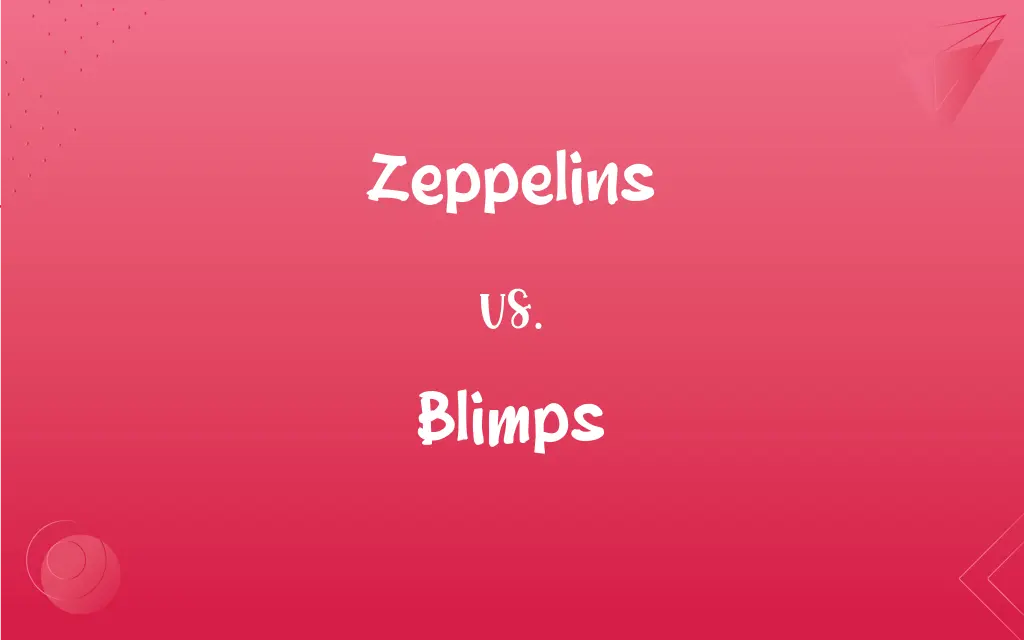Zeppelins vs. Blimps: What's the Difference?
Edited by Aimie Carlson || By Janet White || Published on February 8, 2024
Zeppelins are rigid airships with a metallic framework, while blimps are non-rigid and maintain shape by gas pressure.

Key Differences
Zeppelins, named after Count Ferdinand von Zeppelin, are a type of rigid airship with a structured frame. Blimps, on the other hand, lack a rigid structure and rely on the pressure of the lifting gas (usually helium) to maintain their shape.
The construction of zeppelins involves a framework of aluminum or other metals covered with fabric, which houses gas-filled cells. Blimps are simpler in construction, essentially being large gas bags with a gondola or cockpit attached underneath for passengers and crew.
Zeppelins were historically used for military and passenger transport, especially in the early 20th century. Blimps are more commonly used for advertising, surveillance, and as observational platforms, due to their ease of maneuverability and operation.
The size of zeppelins is typically larger than that of blimps, allowing for greater carrying capacity but requiring more complex ground handling. Blimps, being smaller and more flexible, are easier to operate from various locations with minimal ground support.
In terms of historical significance, zeppelins are often associated with luxury travel and military campaigns, while blimps have found a niche in more peaceful applications like aerial photography and monitoring.
ADVERTISEMENT
Comparison Chart
Structure
Rigid frame
Non-rigid
Size
Generally larger
Smaller
Use
Passenger & military
Advertising & surveillance
Handling
Complex ground operations
Easier to maneuver
Historical Role
Luxury travel & warfare
Peaceful applications
ADVERTISEMENT
Zeppelins and Blimps Definitions
Zeppelins
Zeppelins are historically significant airships used for both commercial and military purposes.
The museum featured a model of a zeppelin, highlighting its use during World War I.
Blimps
Blimps, synonymous with modern lighter-than-air aircraft, are frequently seen at sporting events and festivals.
The blimp added to the festive atmosphere, circling above the outdoor concert.
Zeppelins
Zeppelins are dirigibles distinguishable by their rigid construction.
The engineer marveled at the zeppelin's design, noting the intricacies of its rigid structure.
Blimps
Blimps are often used for advertising and aerial surveillance.
The company's logo was prominently displayed on the side of the blimp.
Zeppelins
Zeppelins are large, rigid airships with an internal framework.
The zeppelin flew gracefully over the city, its silhouette unmistakable against the skyline.
Blimps
Blimps are smaller and more maneuverable than rigid airships.
The pilot skillfully navigated the blimp through the city's skyline.
Zeppelins
Zeppelins, a symbol of aeronautical innovation, have a distinct, elongated shape.
The child's drawing of a zeppelin captured its elongated form and iconic design.
Blimps
Blimps have a gondola or cockpit for crew, attached underneath the gas bag.
From the blimp's gondola, the pilot enjoyed a panoramic view of the landscape.
Zeppelins
Zeppelins are often associated with early 20th-century aviation advancements.
The documentary on zeppelins showcased their role in revolutionizing air travel.
Blimps
Blimps are non-rigid airships kept in shape by internal gas pressure.
The blimp hovered above the stadium, providing aerial coverage of the game.
Zeppelins
A rigid airship having a long cylindrical body supported by internal gas cells.
Blimps
A pompous, reactionary, ultranationalistic person.
Zeppelins
Plural of zeppelin
Blimps
A nonrigid, buoyant airship.
Blimps
(Derogatory) An obese person.
Blimps
(Slang) To become very fat. Often used with out
He's really blimped out since he got that desk job.
Blimps
Plural of blimp
Blimps
Infl of blimp
FAQs
Were zeppelins used in wars?
Yes, zeppelins were used for military purposes, especially during World War I.
What are blimps primarily used for today?
Today, blimps are mostly used for advertising, surveillance, and aerial photography.
How large are zeppelins compared to blimps?
Zeppelins are generally larger than blimps.
How do blimps maintain their shape?
Blimps maintain their shape through internal gas pressure.
Can blimps carry passengers?
Yes, blimps can carry passengers, though typically in smaller numbers than zeppelins.
How long can a zeppelin stay airborne?
Zeppelins could stay airborne for several days, depending on their design and purpose.
What is a zeppelin?
A zeppelin is a type of rigid airship with an internal metal framework.
What kind of gas is used in zeppelins?
Historically, hydrogen was used, but modern airships use helium.
Did zeppelins have engines?
Yes, zeppelins were powered by engines for propulsion.
Are blimps environmentally friendly?
Blimps are relatively eco-friendly, especially when using helium and efficient engines.
How are blimps steered?
Blimps are steered using movable fins and rudders, controlled by the pilot.
Can blimps fly in bad weather?
Blimps are less stable in bad weather compared to heavier aircraft.
What are the advantages of using blimps for advertising?
Blimps offer high visibility and can hover over specific areas for extended periods.
How quickly can a blimp move?
Blimps generally have slower speeds, averaging around 35-50 mph.
Can zeppelins be used for cargo transport?
Historically, zeppelins were used for cargo, but today they are less common for this purpose.
Are blimps safer than zeppelins?
Blimps are considered safer due to their simpler construction and use of inert helium.
Were zeppelins used for transatlantic flights?
Yes, zeppelins were used for transatlantic passenger flights in the early 20th century.
How much does it cost to operate a blimp?
Operating costs vary but are generally lower than for rigid airships due to simpler mechanics.
What are the main components of a zeppelin's structure?
A zeppelin's structure includes a rigid frame, gas cells, a gondola, and propulsion systems.
What ended the era of passenger zeppelins?
The Hindenburg disaster in 1937 largely ended the use of zeppelins for passenger travel.
About Author
Written by
Janet WhiteJanet White has been an esteemed writer and blogger for Difference Wiki. Holding a Master's degree in Science and Medical Journalism from the prestigious Boston University, she has consistently demonstrated her expertise and passion for her field. When she's not immersed in her work, Janet relishes her time exercising, delving into a good book, and cherishing moments with friends and family.
Edited by
Aimie CarlsonAimie Carlson, holding a master's degree in English literature, is a fervent English language enthusiast. She lends her writing talents to Difference Wiki, a prominent website that specializes in comparisons, offering readers insightful analyses that both captivate and inform.
































































